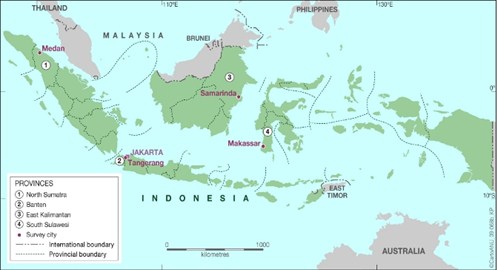Aims
This project will focus on the comparative urbanisation process in China and Indonesia. The research output will improve the understanding of a little-studied area and provide insights to assist policy makers to manage migration movement more effectively. The study will investigate three main research areas:
- The income mobility of migrants and their families and the impact of migration on poverty alleviation.
- The experience of the children of migrants who remain in home villages and those who migrate with their parents
- The assimilation of migrant workers into the city.
Longitudinal survey data specifically designed to study migration issues are required to address the research questions. Annual surveys will be conducted for five consecutive years (2008-12). The sample size each year is 18,000 households in China (5,000 migrant, 5,000 urban and 8,000 rural households) and 2,500 households in Indonesia (both urban and migrant).
Where are surveys conducted?
In China our sample covers the nine-largest provinces sending and receiving migrants. These are: Shanghai, Jiangsu, Zhejiang, Hubei, Sichuan, Guangdong, Henan, Anhui and Sichuan. The Urban Survey is conducted in 15 cities within these provinces – refer to the Urban Household and Urban Migrant pages for more information.
In Indonesia, four major cities are surveyed – Tangerang, Medan, Samarinda and Makassar.
Surveys in each country are conducted by partner organisations under the direction and supervision of the RUMiCI project team.
Each component of the survey work is designed according to the specific needs of that component. More information is provided on the relevant survey page, but in general terms:
China Urban and Rural Household Surveys: RUMiCI’s sampling design for these surveys is based on that of the Annual Rural Household Survey and Annual Urban Household Survey conducted by China’s National Bureau of Statistics (NBS).
China Migrant Household survey: The RUMiCI project team conducts a census in each of the 15 target cities and generates the sampling frame on the basis of the census information.
Indonesia Urban and Migrant surveys: The sampling frame is based on the 2008 National Socioeconomic Survey (SUSENAS) listing information.
Sampling manuals
Questionnaire design
The questionnaires are designed by the research team and in-country collaborators. Surveys are conducted at both household and community level.
The household survey questionnaires each contain a standard palette of questions around household characteristics, education and employment, children and their education, health, general wellbeing, income, expenditure, assets, etc. Specific questions are included in questionnaires targeting different types of respondents, e.g. questions on migration history are included in the urban migrant survey questionnaire.
Community surveys are conducted at village (rural) and Shequ – China or neighbourhood – Indonesia (urban community) level
Survey conduct
In China the rural and urban household surveys are conducted by the NBS, and the migrant survey by a professional survey organisation. In Indonesia the survey is conducted by a team based within the project’s institutional research collaborator, Gadjah Mada University (UGM), Yogyakarta.
China

Survey types
- Urban Migrant Survey
- Urban Household Survey
- Rural Houshold Survey
- Urban Community Survey
- Rural Community Survey
Indonesia

Survey types
- Migrant and Urban Resident Survey
- Urban Community Survey
